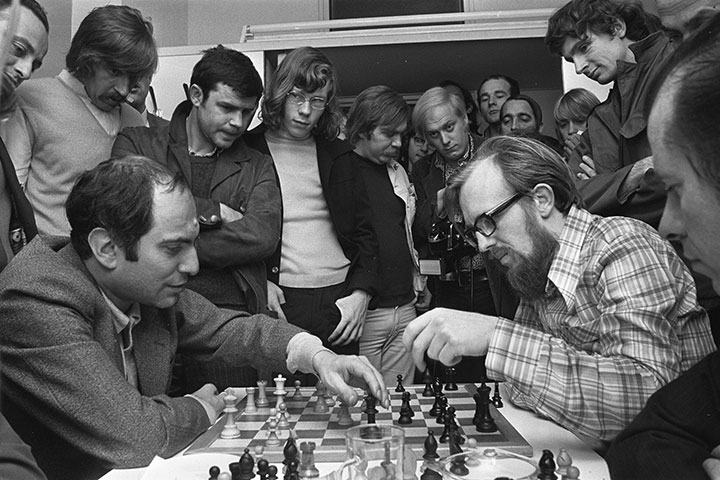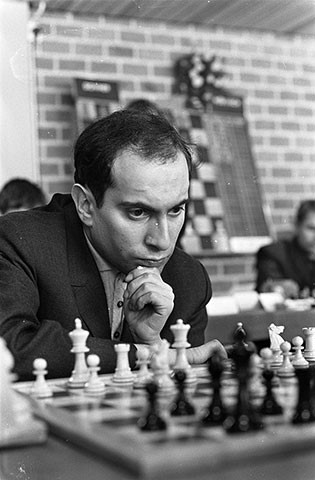


[Note that Jon Speelman also looks at the content of the article in video format, here embedded at the end of the article.]
When I stream at twitch.tv/jonspeelman — at the moment rather sporadically — I sometimes ask for ideas for this column. An Indian guy suggested that I do one on Mikhail Tal, and while we have seen some Tal games recently (notably when he splatted me at the Subotica Interzonal in 1987) I’m very happy to oblige.
 In order to become a grandmaster you have at some stage to be obsessed by chess to the point of being in love with the game. It doesn’t have to persist, and while I myself still very much enjoy both playing and watching chess, my relationship with the game has matured to something more akin to a long term marriage than the passion of youth.
In order to become a grandmaster you have at some stage to be obsessed by chess to the point of being in love with the game. It doesn’t have to persist, and while I myself still very much enjoy both playing and watching chess, my relationship with the game has matured to something more akin to a long term marriage than the passion of youth.
Even the world's very best players don’t necessarily have to be crazy about the game — though they presumably very much like winning. And we are very lucky at the moment to have a world champion in Magnus Carlsen who not only obviously really likes playing but is also at times able to take himself sufficiently unseriously to play extended bullet sessions in which he’s bound to lose a serious number of games.
This is something which you couldn’t possibly imagine the Patriarch Mikhail Botvinnk doing (had the technology been available when he reigned supreme): and indeed Botvinnik reportedly disapproved of blitz chess. But you could certainly see Misha Tal playing blitz and bullet on the internet — he was able to play extremely strongly, even in a state in which the rest of us would have struggled to remain upright.
[Photo: Ron Kroon / Anefo]
I discovered this at the end of the Montetaxco Interzonal in Mexico 1985 — in the cycle which preceded the one in which I qualified to the Candidates via Subotica. I had a reasonable tournament but was never in the mix to qualify, while Tal qualified coming third behind Jan Timman and Jesus Nogueiras.
During and after the tournament there were a couple of times when Tal showed just how much he loved chess and how unflappable he was.
In round 3, Tal adjourned against Ahmed Saeed Saeed from the UAE about here. After a couple of hours’ play Tal won, but in the post-mortem after he’d already shown his opponent how to defend, they realized that Black's queenside pawns had been placed wrongly on the board — presumably on a6 and b7. After some sort of appeal by Saeed, it was agreed that they should play again, and Tal calmly accepted this and beat Saeed a different way!
My second at Montetaxco was Will Watson, the magnificent attacking player who — I think it was Boris Spassky — was described as a “drunken machine gunner”, who later became a very successful lawyer.
At dinner one day during the tournament, one of the other player’s seconds decided to have dinner with us rather than with his principal and his wife. Afterwards one of the iconic conversations in chess history took place, and it went something like:
Principal: “Are you happy?”Second: “Are you bothering me?”Principal: “Are you happy?”Second: “Are you bothering me?”
After which the second was sacked! He definitely lasted longer than I did when I was Victor Korchnoi’s second at the Montpellier Candidates later that year.
After the tournament finished, Will asked Tal if he could play some blitz. Tal was drinking and said that they could do it later, and at some time in the wee hours with Tal fairly stocious Will played him and, not wanting to take advantage of his hero, had a very polite series of games.
When Will had finished, Guillermo Garcia, the Cuban who won one of the big US Opens at one stage (perhaps the World Open?) and very sadly died in a car crash in 1990, sat down opposite the very drunk Tal and set about killing him, drunk or not. On the contrary, Tal slaughtered him!
Tal’s feeling for the initiative and sacrifice has never been bettered.
I could have chosen any of dozens of his games and have gone for this one from the 1960 World Championship match, which I’ve re-annotated taking some notice of the prognostications of our silicon lords and masters, but not too much.
To finish off a very nice if quite slight victory form a few years earlier.